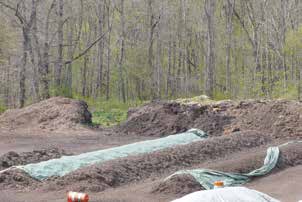chAPter 13 Making and using CoMPosts
even bIrds do It
The male brush turkey of Australia gathers leaves, small branches, moss, and other litter and builds a mound about 3 feet high and 5 feet across. It then digs holes into the mound repeatedly and refills them—helping to fragment and mix the debris.
Final y, the pile is covered with a layer of sticks and twigs. The female lays her eggs in a hole dug into the pile, which heats up to close to 100°F around the eggs while the outside can be around 65°F. The heat of the composting process frees the birds from having to sit on the eggs to incubate them.
—r.s. seyMour (1991)
Accepting and composting lawn and garden wastes
of composting, so it may be necessary to add water to
provide some income for farmers near cities and towns.
a pile. In fact, even in a humid region, it is a good idea
They may charge for accepting the wastes and for selling
to moisten the pile at first, if dry materials are used.
compost. Some farmers, especially those without ani-
However, if something like liquid manure is used to pro-
mals or perennial forage crops that help increase organic
vide a high-nitrogen material, sufficient moisture will
matter, may want to utilize the compost as a source of
most likely be present to start the composting process.
organic matter for their own soils.
The ideal moisture content of composting material is
about 40% to 60%, or about as damp as a wrung-out
MAKINg cOMPOSTS
sponge. If the pile is too dry—35% or less—ammonia is
Moisture
lost as a gas, and beneficial organisms don’t repopulate
The amount of moisture in a compost pile is important.
the compost after the temperature moderates. Very dry,
If the materials mat and rainwater can’t drain easily
dusty composts become populated by molds instead of
through the pile, it may not stay aerobic in a humid
the beneficial organisms we want.
climatic zone. On the other hand, if composting is done
inside a barn or under dry climatic conditions, the pile
Types of Starting Materials
may not be moist enough to allow microorganisms to
The combined organic materials used should have lots
do their job. Moisture is lost during the active phase
of carbon and nitrogen available for the microorgan-
isms to use. High-nitrogen materials, such as chicken
manure, can be mixed with high-carbon materials like
A sAMPLe coMPost recIPe
hay, straw, leaves, or sawdust. Compost piles are often
Start with the following:
built by alternating layers of these materials. Turning
• grass clippings (77% moisture, 45% C, and 2.4% N)
the pile mixes the materials. Manure mixed with saw-
• leaves (35% moisture, 50% C, and 0.75% N)
dust or wood chips used for bedding can be composted
• food scraps (80 % moisture, 42% C, and 5.0% N)
as is. Composting occurs most easily if the average C:N
ratio of the materials is about 25–40 parts carbon for
The ratio of the materials needed to get 60% moisture
every part nitrogen (see chapter 9 for a discussion of
and a C:N of 30:1 is: 100 lbs of grass, 130 lbs of leaves,
C:N ratios).
and 80 lbs of food scraps.
There are too many different types of materials that
—T. RICHARD (1996b)
you might work with to give blanket recommendations
142
Building SoilS for Better CropS: SuStainaBle Soil ManageMent





